Construction & Working Drawings - Discussion
-
What do you hope not, Nick? Or you hope it is never standardized?
You mean each of us must create his or her own textures and these will always be recognizable by all, even neophytes?
I was hoping your pattern library would be available ($)
 . (Though I am far from doing such details myself, this might get me there sooner).
. (Though I am far from doing such details myself, this might get me there sooner). -
@pbacot said:
What do you hope not, Nick? Or you hope it is never standardized?
You mean each of us must create his or her own textures and these will always be recognizable by all, even neophytes?
I was hoping your pattern library would be available ($)
 . (Though I am far from doing such details myself, this might get me there sooner).
. (Though I am far from doing such details myself, this might get me there sooner).My thought is that a material image (photographic) is more telling than a hatch pattern used to define a given material. I don't think there is a need to standardize images used in defining materials. Concrete can look like concrete in many different images. What I love about SU is the customization allowed by the individual user. We are not bound by standards like this anymore.
Using concrete as an example, just search Google images and you will see hundreds of images of concrete. Most all would clearly be seen as concrete given the context of application to a given foundation model/section/detail. There is no need for a standard pattern any more. I would hate to go back to that, so I really hope that is not something Trimble deems necessary for either SU or LO. I would much rather the focus be placed on getting us even further beyond what has been the industry standard.
-
@bmike said:
@unknownuser said:
Mike, where did you go to school. Sounds a lot like my school - RISD.
Cleveland Institute of Art, BFA Sculpture, but I spent time in ID, Graphics, and lots of time working for carpenters and woodworkers.
Then to Columbia for Grad school in Architecture. Burned out after a year. Too much $$$$ for living in the city and going to school, and lots of folks who didn't seem to care about the art of actually building...
Had a good friend go to RISD for furniture. This would have been in mid 90s. Spent some time there hanging out, fun town. Will be there in 2 weeks visiting and engineer I work with and doing some warranty research on a project I designed a few years ago.
Also know a prof down at RISD via some artists I worked for as an assistant in NYC and a by way of a project that I worked on in Jamestown.
Small world.
I know, crazy. I see you are in Vermont. I went to Kimball Union Academy near White River Junction.
-
@pbacot said:
What do you hope not, Nick? Or you hope it is never standardized?
You mean each of us must create his or her own textures and these will always be recognizable by all, even neophytes?
I was hoping your pattern library would be available ($)
 . (Though I am far from doing such details myself, this might get me there sooner).
. (Though I am far from doing such details myself, this might get me there sooner).To hell with the neophytes! (Ok just kidding, well sort of) I think simple hatch patterns will always have a place in architectural drawing. I like to just remove all the color from materials (will someone write me a plug in to change them back and forth from color to monochrome) What I want is copies of everybodies scrapbooks. How come there is no scrapbook warehouse ? (yes I'm lazy)
-
A long while since my last post. Here is the last job I did using only Sketchup & Layout from start to finish. I have only done a few jobs solely in SU LO, as most of my work consists of AutoCAD in one form or another. But I'm trying to avoid it as much as possible now.
One big help was making groups from slices. I saw this in one of Nick Sonders videos. I don't know how I missed that one in the past??? Also a good tip from Nick was try and do as little in LO as possible, basic text & line work etc. I think maybe this is where I was getting frustrated a bit!!! Trying to do to much in LO...?
A big thanks to Nick as his videos really are a help.
The job below is just a basic single storey extension (UK) There is more info on there "graphically" than I would normally supply in a set of AutoCAD plans, hence the time involved is also greater than I would normally take. I need to stop messing about and be more productive

Gaz...
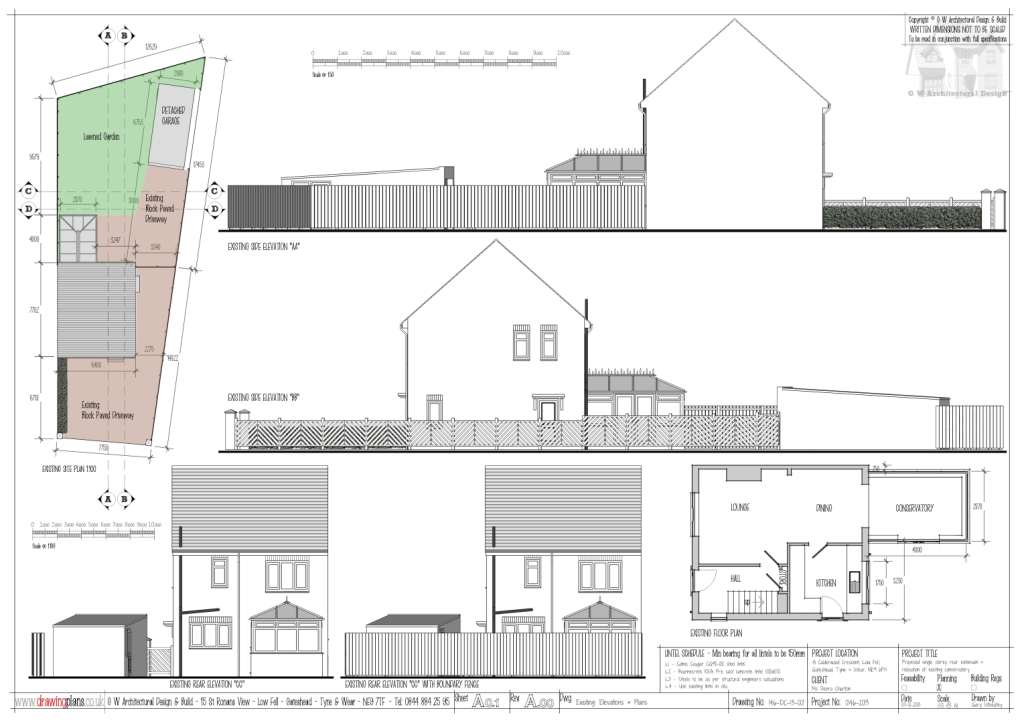
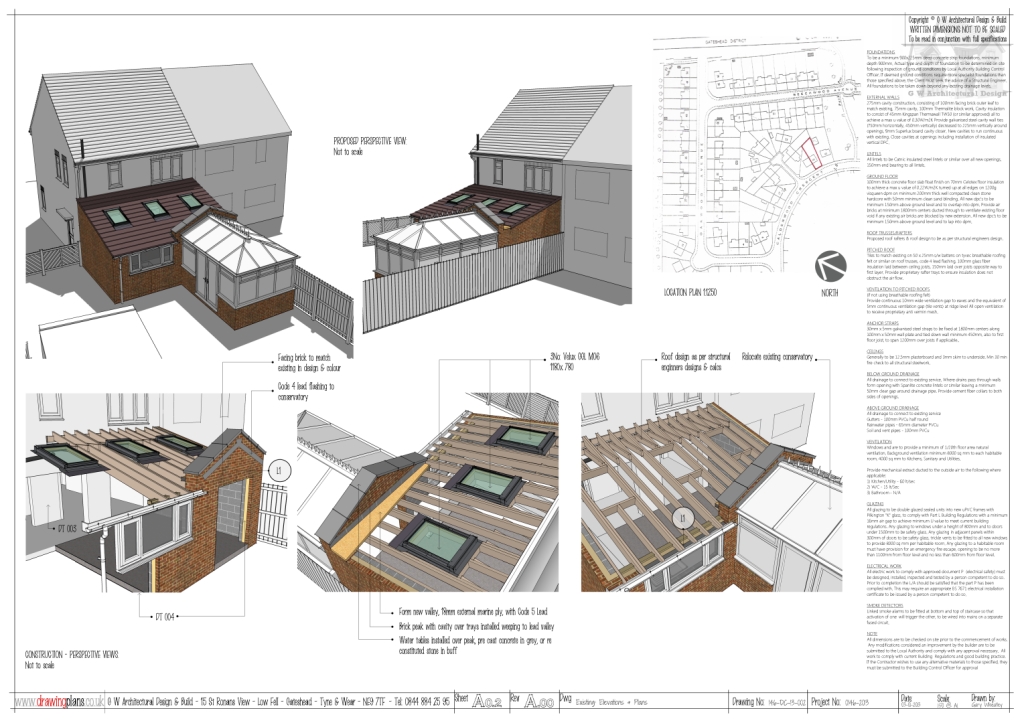
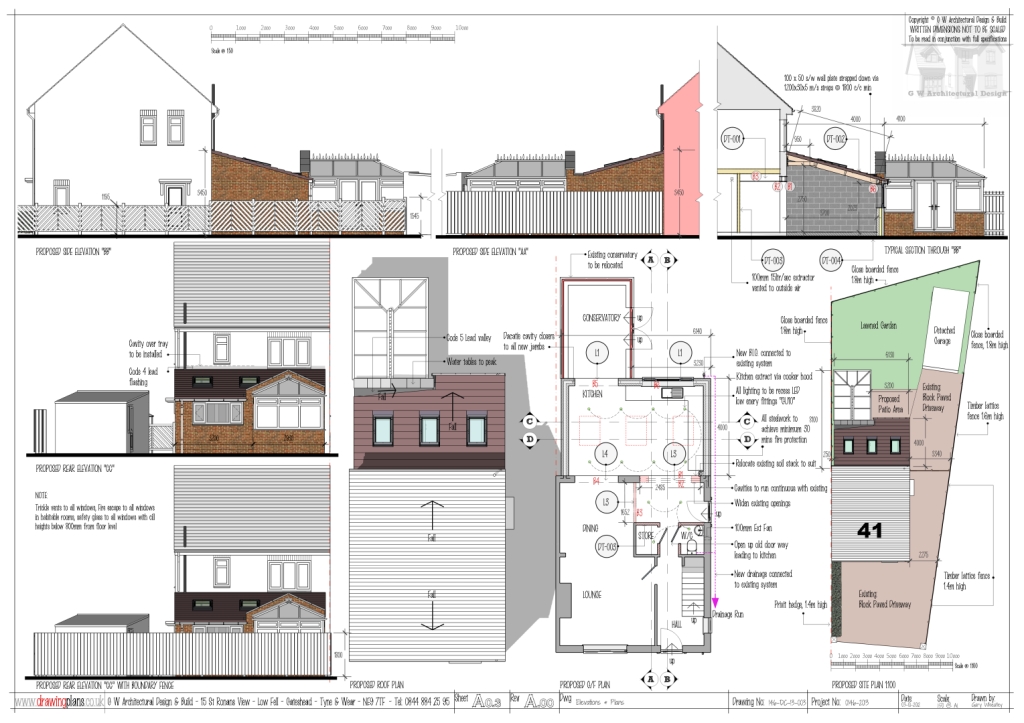
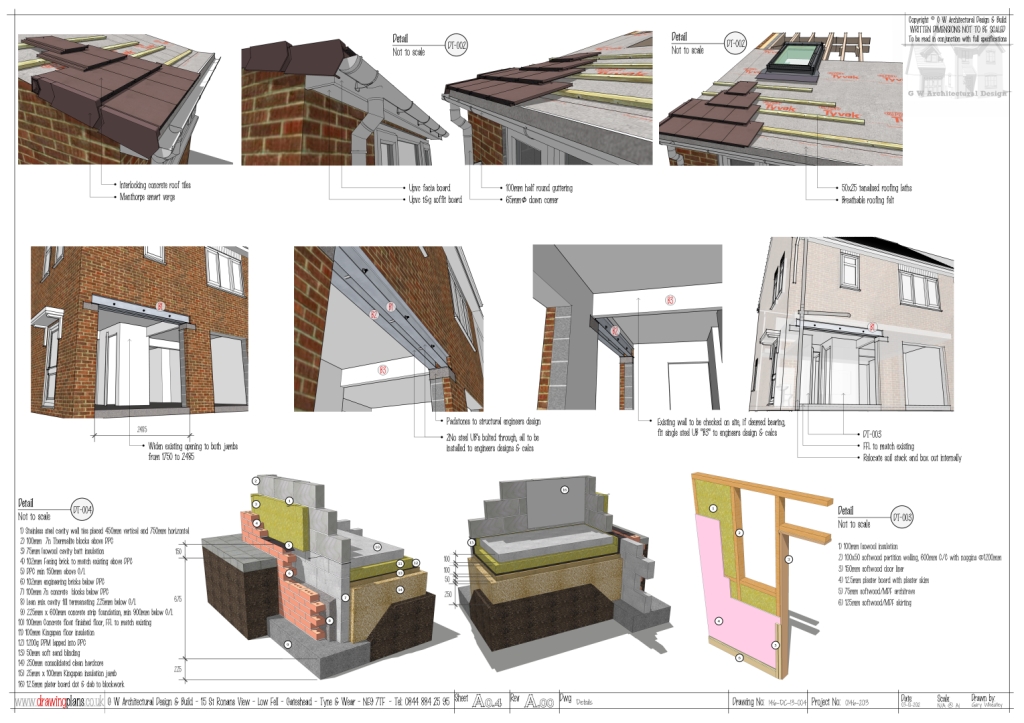
-
Very nice work!
-
many compliments very well done work
-
YES. This looks very advanced, even if you feel you spending too much time. (You're shaming the competition.)
-
How the height dimensions are done in Layout?
-
@zx10r_gaz said:
The job below is just a basic single storey extension (UK) There is more info on there "graphically" than I would normally supply in a set of AutoCAD plans, hence the time involved is also greater than I would normally take. I need to stop messing about and be more productive

Gaz...
[attachment=3:ckktjyo7]<!-- ia3 -->A01-1024.jpg<!-- ia3 -->[/attachment:ckktjyo7]
I can't believe how much scaled information you can get on a sheet. very efficient. and yet still very attractive.
-
@unknownuser said:
I can't believe how much scaled information you can get on a sheet. very efficient. and yet still very attractive.
Krisidious,
All drawings are on A1 size media. This is:841 x 594mm or 33.1" x 23.4". All 2D scales are 1:50, or 1:100 if there is not quite enough room.
Gaz...
-
I use 1/48 or 1/4"= 1'0" on 24"x36" paper... Normally my issue is elevations and plans will not fit together. much less all the other things you've fit.
-
I am inserting a scene from SU into Layout. This happens to be a Plan Section but my question would apply to all Section Cuts. The scene consists of two groups (as shown in Outliner), the model group itself and the linework group that has been created with "Create group from slice" and 'faced' ala Nick Sonder's videos. To clarify: the Linework Group is outside of the Model Group. Now I am led to believe according to this discussion that once Inserted into Layout, the Model itself should be Raster rendered and the Linework should be Vector rendered? According to Nick's procedure he uses a separate SU model referenced to his Master Base Model, which contains only Linework. My understanding is that he then Inserts the "Model Group" and then as a second Insertion he inserts the "Linework Group" into Layout? My setup is different: I am not using a referenced "Parent - Child" x-ref arrangement. I have one scene (consisting of 2 groups) and one Insertion. How do I raster render one and vector render the other when they are both coming into Layout simultaneous? Once I have Inserted the Scene, am I able to edit it (in Layout) by selecting a specific group as one does in SU itself? I hope I am not missing something but this is the first time I am using Layout fror CD's.
-
@smarque said:
I have one scene (consisting of 2 groups) and one Insertion. How do I raster render one and vector render the other when they are both coming into Layout simultaneous? Once I have Inserted the Scene, am I able to edit it (in Layout) by selecting a specific group as one does in SU itself? I hope I am not missing something but this is the first time I am using Layout fror CD's.
You can only set rendering per 'viewport'. If you want 2 items rendered with different settings, you'll need to have 2 'viewports'. This is why / how sonder stacks the 2 over each other. So in 1 viewport you would have the model turned on with the section cut active. The other viewport would have the model turned off and the section slice group as the only thing active. The two windows would be stacked on top of each other.
Also, check out the 'SectionCutFace' plugin. Huge timesaver.
-
I have inserted a SU file (the file itself is a 'child' file imported from a 'parent' file) into layout. This inserted SU file came into layout with the viewport 'filled in" with a light background color, which is opaque. This means that this solid face prevents one from looking through the viewport. Even after clicking out of the viewport with the viewport boundary not visible, you can see the rectangle of background color. Not only that but the output quality is very poor. This all came about while putting together reflected ceiling plans. I imported the file, mirrored the model about the z axis. Everything looks fine in SU. Anyone have an idea of what could be causing this. Thanks Mike for the advice with "stacking viewports', it got me up and running just fine.
-
You can turn the background off in the viewports.(assuming you don't have a ground plane drawn in) Look for a check box in the model tab. I believe it is on the secondary tab.
Also, image quality for 'working' is generally lower than for printing. You can change this as well. I think it is under general settings, or in document settings.
-
The only Background I could find is the check box to the right of the fog button. It is linked to the Fog button and did not help my problem.
When I commented on quality, I am comparing it with other view ports on the same page. It is not good. It looks like I have inserted a poor quality Raster image not a SU model. -
this one?
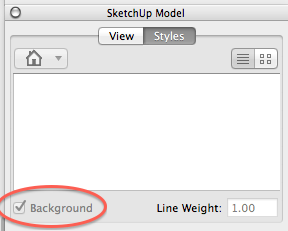
-
I stumbled upon the 6 Sonder videos, then this forum, which inspired me to share my experiences. It's great to see what you folks are doing, but overall I'm not ready to jump to Layout for anything. See below for why it's not yet worth it to me.
Background: I'm a sole proprietor (like Nick Sonder) doing houses, additions and renovations. No employees. I do all my own drawings including structural and electrical.
(see millikenarchitecture.com for examples of 3D and 2D DESIGN drawings.) I never use a pencil. (except on site to record existing conditions for a reno.)Mid 90's I adopted Shapeware's Visio (in beta and long before Microsoft bought it) for 2D. I found it much better than AutoCad especially for plan design and also for CDs.
Then I jumped on @last.com's Sketchup in Beta in 2000 and adopted it for 3D. At the time Sketchup was called ("Visio on steroids"). Long before Layout existed I evolved a workflow for construction documents very similar to Sonder's but using Visio instead of Layout for 2D.
(exporting jpegs from Sketchup and importing to Visio for elevations and sections, and section cuts for section drawings to Visio, then adding dimensions, masks, grade lines, notations etc.) The Layout approach involves less redundancy because the 3D model is referenced dynamically but unfortunately the section cuts cannot be.I looked at Layout at each release to replace Visio but believe it has a long way to catch up for both preliminary design AND construction drawings. The main problem with Layout is that scrapbook objects are dumb. I'm no fan of parametrics for most physical objects, but for notational objects, Layout is limited to standard dimensions. Visio has dozens of indispensable smart notational objects and an easy way of making your own. For instance:
Preliminary Site Design: Zoning limits are always crucial for my work. I start with the survey which I can input using smart boundary dimensions (bearing, arc length and angle, and closing bearing); then add zoning setbacks (smart offset dimension lines straight and curved, dimension drop from point perpendicular to property line); and smart area labels for overall site area and footprints of existing and proposed structures and decks. I can insert a live referenced and properly formatted excel object to show allowable coverage calculations.
Preliminary Floor plans: Visio is excellent for 2D design iteration and layout of SPACES. At this stage I want to manipulate 2D spaces (rooms) not walls. Visio has smart room labels showing overall room dimensions like real estate plans like to show and clients can read. When I'm ready, Visio has dynamic self joining wall objects and an overall grid environment that makes 2D design and iteration very quick. I can poche walls to correspond to various types (new, existing, demolished). It also has multiple object alignment tools, equal spacing tools and polygon Boolean tools still missing from Layout. (Nothing ever has to be "exploded" to proceed further so smarts are never lost.)
3D Design: Once I develop a few preliminary plan schemes in 2D: then I export to Sketchup to begin the process you all use.
Construction Drawings: When my client chooses a design scheme, then I start CDs as I described at the top. Again Visio's smart shapes beat Layout hands down.
Of course Visio has a somewhat different interaction environment than Sketchup, but then again so does Layout.
Eventually I hope Trimble integrates the entire Sketchup/Layout system into one program with two modes: 2D and 3D. Then if they enable smart scrapbook objects, I'm ready to switch.
If you want examples of my CDs in PDF I can upload.
-
Welcome Barry! Layout definitely has its quirks currently. However, over time I have completely adapted. It is so much faster for me to create a full set of CD's than I could with ACAD. The use of the single 3d model also relieves so much stress about coordination. As for the section and plan linework I use, yes you do need to update that information in the model. That is generally a task that only takes minutes.
I recently got my structural engineer addicted to the process. So far it is really impressive. I'll post some images of our first project that is getting submitted to the building department this April. It is a good sized home - 5,100 sf and every drawing in the set will be a product of SU and LO.
Advertisement







